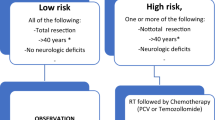Abstract
High-grade gliomas are an infrequent disease diagnosed usually in the fifth or sixth decade. Careful histopathological diagnosis is essential because tumour grade and type condition the treatment. Magnetic resonance with gadolinium is considered the standard radiologic exploration and should be followed by tissue sampling. Treatment of these patients should be decided in a multidisciplinary committee. Surgery, radiotherapy and chemotherapy are the basis of patients’ treatment, with the best results obtained when the three of them can be used.
Similar content being viewed by others
References
Daumas-Duport C, Scheithauer B, O'Fallon J, Kelly P (1988) Grading of astrocytomas. A simple and reproducible method. Cancer 62:2152–2165
Wood JR, Green SB, Shapiro WR (1988) The prognostic importance of tumor size in malignant gliomas: a computed tomographic scan study by the Brain Tumor Cooperative Group. J Clin Oncol 6:338–343
Wallner KE, Galicich JH, Krol G et al (1989) Patterns of failure following treatment for glioblastoma multiforme and anaplastic astrocytoma. Int J Radiat Oncol Biol Phys 16:1405–1409
Stewart LA (2002) Chemotherapy in adult highgrade glioma: a systematic review and meta-analysis of individual patient data from 12 randomised trials. Lancet 359:1011–1018
Stupp R, Mason WP, van den Bent MJ et al (2005) Radiotherapy plus concomitant and adjuvant temozolomide for glioblastoma. N Engl J Med 352: 987–996
Westphal M, Ram Z, Riddle V et al (2006) Gliadel wafer in initial surgery for malignant glioma: long-term follow-up of a multicenter controlled trial. Acta Neurochir (Wien) 148:269–275; discussion 275
Keime-Guibert F, Chinot O, Taillandier L et al (2007) Radiotherapy for glioblastoma in the elderly. N Engl J Med 356:1527–1535
Chinot OL, Barrie M, Frauger E et al (2004) Phase II study of temozolomide without radiotherapy in newly diagnosed glioblastoma multiforme in an elderly populations. Cancer 100:2208–2214
Balana C, Lopez-Pousa A, Berrocal A et al (2004) Phase II study of temozolomide and cisplatin as primary treatment prior to radiotherapy in newly diagnosed glioblastoma multiforme patients with measurable disease. A study of the Spanish Medical Neuro-Oncology Group (GENOM). J Neurooncol 70:359–369
Wick W, Hartmann C, Engel C et al (2009) NOA-04 randomized phase III trial of sequential radiochemotherapy of anaplastic glioma with procarbazine, lomustine, and vincristine or temozolomide. J Clin Oncol 27:5874–5880
Levin VA, Silver P, Hannigan J et al (1990) Superiority of post-radiotherapy adjuvant chemotherapy with CCNU, procarbazine, and vincristine (PCV) over BCNU for anaplastic gliomas: NCOG 6G61 final report. Int J Radiat Oncol Biol Phys 18:321–324
Prados MD, Scott C, Curran WJ Jr et al (1999) Procarbazine, lomustine, and vincristine (PCV) chemotherapy for anaplastic astrocytoma: a retrospective review of radiation therapy oncology group protocols comparing survival with carmustine or PCV adjuvant chemotherapy. J Clin Oncol 17:3389–3395
Brandes AA, Nicolardi L, Tosoni A et al (2006) Survival following adjuvant PCV or temozolomide for anaplastic astrocytoma. Neuro Oncol 8: 253–260
Cairncross G, Berkey B, Shaw E et al (2006) Phase III trial of chemotherapy plus radiotherapy compared with radiotherapy alone for pure and mixed anaplastic oligodendroglioma: Intergroup Radiation Therapy Oncology Group Trial 9402. J Clin Oncol 24:2707–2714
van den Bent MJ, Carpentier AF, Brandes AA et al (2006) Adjuvant procarbazine, lomustine, and vincristine improves progression-free survival but not overall survival in newly diagnosed anaplastic oligodendrogliomas and oligoastrocytomas: a randomized European Organisation for Research and Treatment of Cancer phase III trial. J Clin Oncol 24:2715–2722
van den Bent MJ, Hoang-Xuan K, Ariela Brande A et al (2012) Long-term follow-up results of EORTC 26951: A randomized phase III study on adjuvant PCV chemotherapy in anaplastic oligodendroglialtumors (AOD). J Clin Oncol 30:Suppl, abstr 2
van den Bent MJ, Keime-Guibert F, Brandes AA et al (2001) Temozolomide chemotherapy in recurrent oligodendroglioma. Neurology 57:340–342
Ducray F, del Rio MS, Carpentier C et al (2011) Up-front temozolomide in elderly patients with anaplastic oligodendroglioma and oligoastrocytoma. J Neurooncol 101:457–462
Brem H, Piantadosi S, Burger PC et al (1995) Placebo-controlled trial of safety and efficacy of intraoperative controlled delivery by biodegradable polymers of chemotherapy for recurrent gliomas. The Polymer-brain Tumor Treatment Group. Lancet 345:1008–1012
Trent S, Kong A, Short SC et al (2002) Temozolomide as second-line chemotherapy for relapsed gliomas. J Neurooncol 57:247–251
Berrocal A, Perez Segura P, Gil M et al (2010) Extended-schedule dose-dense temozolomide in refractory gliomas. J Neurooncol 96:417–422
Brada M, Stenning S, Gabe R et al (2010) Temozolomide versus procarbazine, lomustine, and vincristine in recurrent high-grade glioma. J Clin Oncol 28:4601–4608
Wen PY, Macdonald DR, Reardon DA et al (2010) Updated response assessment criteria for high-grade gliomas: response assessment in neuro-oncology working group. J Clin Oncol 28: 1963–1972
Author information
Authors and Affiliations
Corresponding author
Rights and permissions
About this article
Cite this article
Berrocal, A., Gil, M., Gallego, Ó. et al. SEOM guideline for the treatment of malignant glioma. Clin Transl Oncol 14, 545–550 (2012). https://doi.org/10.1007/s12094-012-0839-6
Received:
Accepted:
Issue Date:
DOI: https://doi.org/10.1007/s12094-012-0839-6




